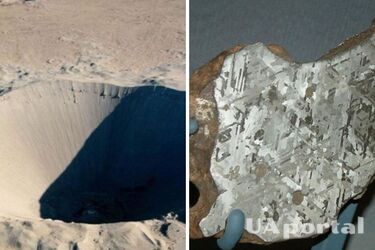Diamonds unknown to science found in a meteorite from Diablo Canyon in the USA

While examining the fragments of a meteorite found in Diablo Canyon in the United States, scientists noticed that it contained previously unknown diamonds. They could have been formed due to the extreme temperatures and pressures that occur when a space rock crashes into the Earth.
IFLScience reports that scientists have noticed unusual compounds in the meteorite debris, and these were diamonds with an unusual structure. The meteorite fell in this canyon about 50,000 years ago, creating the Meteorite Crater, one of the most pristine in the world.
Read also: Scientists have named a city that could sink under the weight of skyscrapers
"When scientists used advanced imaging techniques to examine diamonds from the Canyon Diablo meteorite, they found that these are no ordinary gems. In a 2022 study, researchers reported that these stones have the same hardness as diamonds, but they are extremely ductile. In addition, they have electronic properties that can be tuned, making them potentially useful for electronics," the publication writes.
The meteorite contained a rare form of carbon called lonsdaleite, and it was previously thought to be composed of atoms in a hexagonal lattice. However, when Dr Peter Nemeth of the Institute for Geological and Geochemical Research and co-authors of the study examined the lonsdaleite using Raman spectroscopy and crystallography, they discovered something much more interesting. It turned out that lonsdaleite actually contains traditional cubic diamonds and graphene-like domains that have grown together in so-called diaphytes. The crystal also contains numerous errors where the atoms are misaligned.
"By recognising the different types of splicing between graphene and diamond structures, we can come closer to understanding the pressure and temperature conditions that would occur during an asteroid impact," explained Dr Peter Nemeth.
Read also: American scientist warns of the dangers of artificial intelligence
He said that where diamond and graphene meet, unexpected things happen to the distance between the layers, which explains previous spectroscopic observations of lonsdaleite.
The available quantities of lonsdaleite were too small to test some of its properties. However, modelling suggests that the hexagonal shape should be 58 per cent harder than ordinary diamonds. How hard diaphytes can be remains to be seen.
The authors of the study claim that the compounds obtained from lonsdaleite can be applied to other carbon-rich materials that contain significant amounts of other elements under extreme pressure.
Co-author Professor Christoph Salzmann of University College London explained that these crystals have a number of potential applications: "By controlling the growth of layers of structures, it should be possible to develop materials that are both superhard and ductile, and that have adjustable electronic properties from conductor to insulator." Salzman believes that they could have "a variety of applications from abrasives and electronics to nanomedicine and laser technology".
For reference: The Canyon Diablo meteorite, which fell about fifty thousand years ago and has been known to people living in the northern Arizona region for thousands of years, was scientifically discovered in the nineteenth century. The meteorite itself is approximately 5 billion years old, compared to the age of the Earth, which is only 4.6 billion years old.
The impact of the meteorite is the cause of the Meteor Crater near Flagstaff, Arizona, also known as the Berringer Crater and, in one place, the Diablo Canyon Crater. The impact created a crater over 1200 metres in diameter and 200 metres deep. It is believed that the meteorite itself could have weighed 700,000 tonnes.
So far, 30 tonnes of meteorite fragments have been collected, with the largest fragment weighing 639 kg. The meteorite itself had a predominantly iron-nickel composition, which accounts for 90% of the recovered material in addition to a list of additional ores present in its chemical composition.
Earlier, scientists predicted when the Sun might go out.
If you want to get the latest news about the war and events in Ukraine, subscribe to our Telegram channel!
